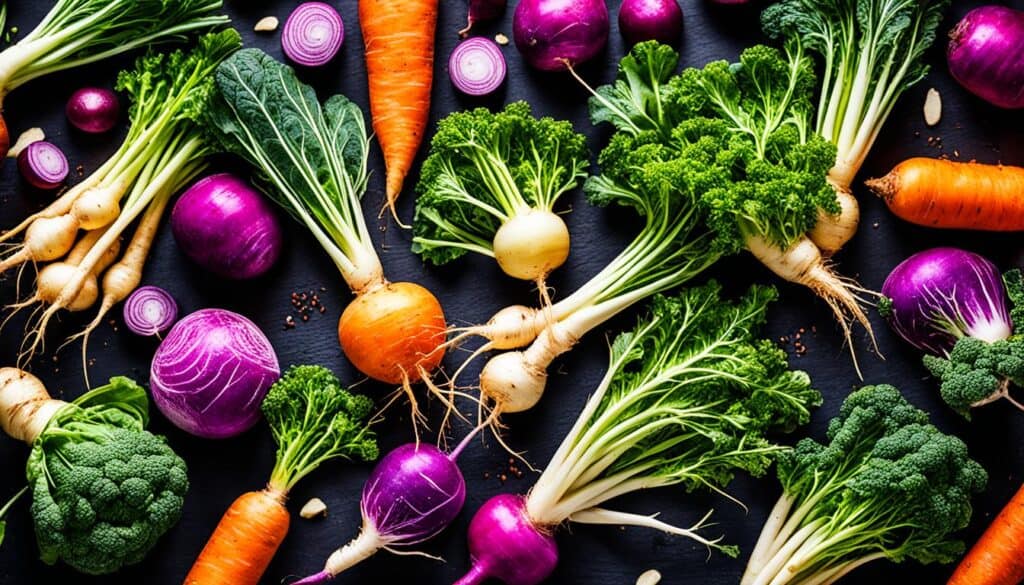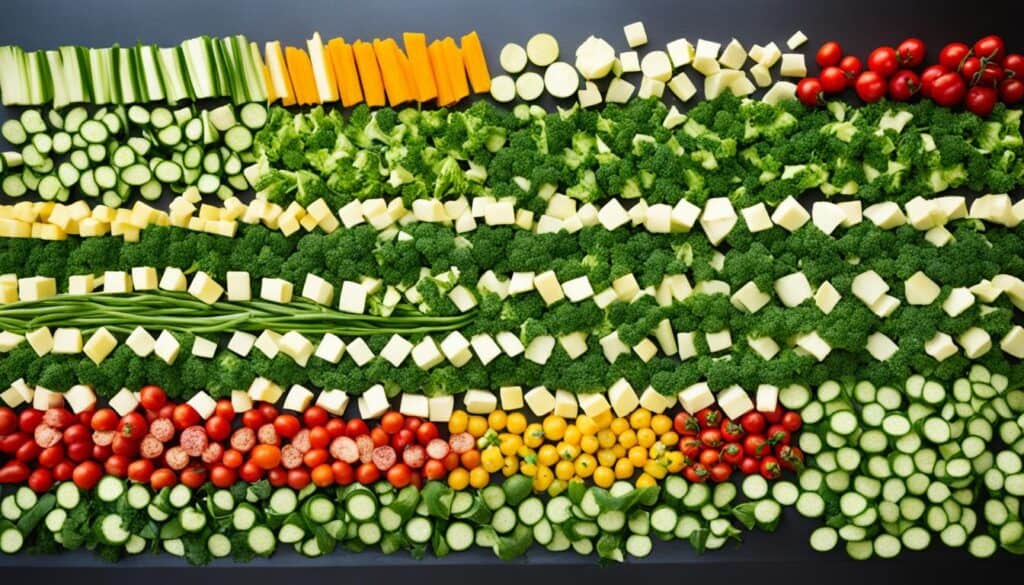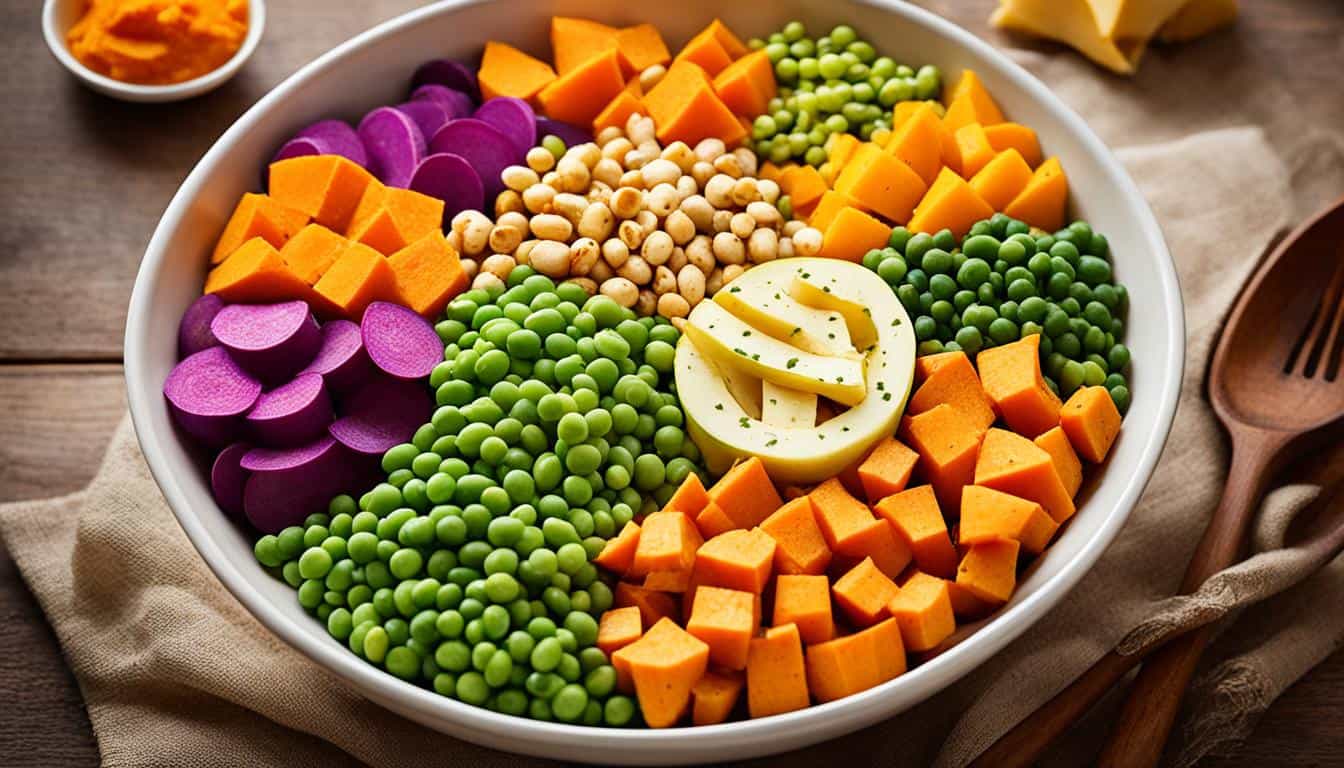Did you know that starchy vegetables can be a powerhouse of energy and nutrients for your body? These vegetables, known for their high carbohydrate content, provide a surprising range of health benefits that you may not be aware of. Whether you are trying to lose weight, maintain a healthy lifestyle, or simply want to incorporate more nutritious options into your meals, starchy vegetables can be a fantastic addition to your diet.
Key Takeaways:
- Starchy vegetables are a good source of energy due to their high carbohydrate content.
- They are low in calories and fat, making them a healthy option for weight management.
- Starchy vegetables are rich in fiber, vitamins, minerals, and antioxidants.
- Including starchy vegetables in a balanced diet can help improve energy levels and overall well-being.
- However, it is important to consume starchy vegetables in moderation, especially for individuals with diabetes or specific dietary restrictions.
Types of Starchy Vegetables
When it comes to starchy vegetables, there is a wide variety to choose from. These vegetables are not only delicious but also high in carbohydrates and packed with essential nutrients. Here is a list of popular starchy vegetables:
| Vegetable | Description |
|---|---|
| Potatoes | A versatile vegetable that can be boiled, roasted, or mashed. |
| Corn | A sweet and flavorful vegetable that can be grilled, steamed, or added to soups and salads. |
| Sweet potatoes | A nutritious and delicious vegetable known for its vibrant orange color. |
| Peas | A small but mighty vegetable that can be enjoyed fresh or cooked. |
| Winter squash | A hearty vegetable that adds a rich and earthy flavor to dishes. |
| Beetroot | A colorful vegetable that can be roasted, pickled, or added to salads. |
| Cassava | A root vegetable commonly used in Latin American and African cuisines. |
| Parsnips | A slightly sweet vegetable often used in soups, stews, and roasted dishes. |
| Wheat | A versatile grain that can be ground into flour or cooked whole. |
| Rice | A staple food in many cultures, available in various forms such as white, brown, and wild. |
| Acorn squash | A nutty and sweet vegetable that can be baked, steamed, or stuffed. |
| Butternut squash | A popular vegetable with a sweet and creamy texture, perfect for roasting or making soup. |
| Turnips | A versatile vegetable that can be enjoyed raw, cooked, or used as a substitute for potatoes. |
| Carrots | A crunchy and vibrant vegetable that is commonly used in soups, salads, and stir-fries. |
These starchy vegetables provide a substantial source of energy and can be enjoyed in a variety of dishes. Incorporating them into your meals adds flavor, texture, and nutritional value to your diet.
As you can see, there is a diverse selection of starchy vegetables to choose from. From the humble potato to the colorful beetroot, each vegetable brings its own unique taste and nutritional benefits to the table. Experimenting with different starchy vegetables can help make your meals more exciting and nutritious.
Nutritional Value of Starchy Vegetables
When it comes to the nutritional value of starchy vegetables, they offer more than just carbohydrates. These vegetables are packed with essential nutrients that contribute to overall health and well-being. Let’s take a closer look at the key nutritional components that make starchy vegetables a wholesome choice.
Fiber
Starchy vegetables are rich in fiber, which plays a crucial role in digestion and maintaining a healthy gut. Dietary fiber aids in proper digestion, helping to prevent constipation and promoting regular bowel movements. It also plays a role in reducing the risk of heart disease by helping to lower cholesterol levels. Incorporating fiber-rich starchy vegetables into your diet can contribute to a healthier digestive system and improved overall well-being.
Vitamins and Minerals
Starchy vegetables are a good source of vitamins and minerals that support various bodily functions and promote optimal health. These vegetables are particularly rich in vitamin C, which boosts immunity and helps protect against cell damage. Starchy vegetables also contain vitamin B, which supports energy production and brain function. Additionally, they are a valuable source of potassium, an essential mineral that aids in maintaining proper nerve function and controlling blood pressure. The exact vitamin and mineral content may vary slightly depending on the specific starchy vegetable.
Antioxidants
Starchy vegetables are packed with antioxidants that help protect the body against oxidative stress and fight off harmful free radicals. Antioxidants, such as vitamin C and other phytochemicals found in starchy vegetables, play a vital role in maintaining overall health and reducing the risk of chronic diseases. These powerful compounds help protect cells from damage, promote healthy aging, and boost the body’s natural defense systems.
Manganese
Some starchy vegetables, like green peas, offer a significant amount of manganese. Manganese is an essential mineral that helps support bone health, aids in collagen production, and plays a role in the body’s antioxidant defense system. Incorporating starchy vegetables rich in manganese, like green peas, into your diet can help meet your daily manganese needs.
| Starchy Vegetable | Fiber (grams) | Vitamin C (milligrams) | Potassium (milligrams) | Manganese (milligrams) |
|---|---|---|---|---|
| Potato (1 medium) | 2 | 27 | 620 | 0.3 |
| Corn (1 ear) | 3.6 | 3.9 | 290 | 0.2 |
| Sweet Potato (1 medium) | 3.8 | 23 | 550 | 0.3 |
| Green Peas (1 cup) | 8.8 | 58 | 370 | 1.5 |
Note: Nutritional values are approximate and may vary depending on factors such as cooking methods and the specific variety of the starchy vegetable.
Adding starchy vegetables to your diet not only provides a great source of carbohydrates but also offers the added benefits of fiber, vitamins, minerals, and antioxidants. Incorporating a variety of starchy vegetables into your meals can contribute to a well-rounded and nutritious diet that supports optimal health.
Benefits of Starchy Vegetables

When it comes to nutrition, starchy vegetables offer a wide range of benefits. These vegetables, rich in carbohydrates, provide the body with sustained energy, making them an excellent fuel source for physical activity. But that’s not all! Starchy vegetables also pack a punch of fiber, essential vitamins, minerals, and antioxidants, which contribute to overall health and well-being.
The fiber content in starchy vegetables plays a crucial role in maintaining regular bowel movements and promoting digestive health. Additionally, consuming an adequate amount of fiber can lower the risk of heart disease and other chronic conditions.
Let’s take a closer look at the nutritional value of these vegetables. They are an abundant source of vitamins, including vitamin C and various B vitamins. These vitamins support immune function, collagen production, and energy metabolism. Starchy vegetables are also rich in minerals like potassium, which helps maintain proper body fluid balance and supports healthy nerve and muscle function.
Furthermore, starchy vegetables are a powerhouse of antioxidants, which protect the body from free radicals and oxidative stress. Antioxidants contribute to cellular health and may reduce the risk of chronic diseases such as cancer and heart disease.
Incorporating starchy vegetables into a balanced diet comes with a plethora of perks. Not only do they provide sustained energy and help manage weight, but they also contribute to improved energy levels and overall vitality.
Take a look at the table below to explore the nutritional content of common starchy vegetables:
| Starchy Vegetable | Carbohydrates (g) | Fiber (g) | Vitamin C (mg) | Potassium (mg) |
|---|---|---|---|---|
| Potato (1 medium) | 37 | 4 | 27 | 620 |
| Corn (1 cup) | 41 | 5 | 17 | 416 |
| Sweet Potato (1 medium) | 23 | 4 | 22 | 438 |
| Parsnips (1 medium) | 26 | 5 | 18 | 499 |
As you can see, each vegetable brings its unique nutritional profile to the table. Incorporating a variety of starchy vegetables into meals ensures a diverse array of nutrients, contributing to optimal health.
With all the benefits starchy vegetables have to offer, it’s easy to see why they deserve a prominent place on your plate!
In the next section, I’ll dive into the various ways you can prepare and cook starchy vegetables to retain their nutritional value and enhance their flavors. Stay tuned!
Cooking Starchy Vegetables

When it comes to cooking starchy vegetables, there are many delicious options to choose from. These vegetables can be prepared in various ways that not only retain their nutritional value but also enhance their flavor. Whether you prefer roasted, boiled, steamed, or mashed starchy vegetables, there’s a recipe that will tantalize your taste buds.
To make roasted starchy vegetables, simply toss them in olive oil, sprinkle with your favorite herbs and spices, and roast them in the oven until they are golden brown and crispy. This cooking method brings out the natural sweetness of the vegetables and adds a delightful crunch to your dish. For an extra touch of flavor, try adding garlic or rosemary to your roasted potatoes or butternut squash.
“Roasting starchy vegetables brings out their natural sweetness and adds a delightful crunch to your dish.”
If you prefer softer textures, boiling or steaming starchy vegetables is a great choice. Boiling them until they are tender allows you to easily mash them into creamy, fluffy goodness. Mashed potatoes and mashed sweet potatoes are classic favorites that can be enjoyed on their own or as a side dish. Add a little butter or olive oil and season with salt and pepper for a simple yet satisfying comfort food.
Corn chowder is another popular recipe that showcases the deliciousness of starchy vegetables. Combining corn kernels with potatoes, onions, and vegetable broth creates a creamy and flavorful soup that is perfect for cold winter nights. Sprinkle some fresh herbs on top for an extra pop of freshness.
For a show-stopping dish, try stuffed acorn squash. Scoop out the seeds and fill the hollowed-out squash with a delicious mixture of cooked rice, vegetables, and spices. Bake until the squash is tender and the filling is perfectly cooked. This visually appealing dish is not only a treat for the eyes but also a burst of flavors.
When cooking starchy vegetables, it’s important to be mindful of the cooking methods you choose. Deep-frying or adding excessive amounts of butter or oil can significantly increase the calorie and fat content of the dish. To keep your starchy vegetable recipes healthy, opt for healthier cooking methods like roasting or steaming and use herbs, spices, and healthy fats like olive oil or coconut oil to enhance the taste.
Now that you have some recipe ideas, it’s time to get cooking! Explore the world of starchy vegetables and let your culinary creativity shine.
Starchy Vegetables for Weight Loss

Contrary to popular belief, starchy vegetables can be a valuable addition to a weight loss diet. These vegetables are not only low in calories and fat but also high in fiber, making them an ideal choice for those looking to shed pounds. Including starchy vegetables in balanced meals can provide a sense of fullness, preventing overeating and reducing the consumption of calorie-dense foods. However, it is important to control portion sizes and opt for healthier cooking methods to maximize the weight loss benefits of starchy vegetables.
| Starchy Vegetable | Calories (1 cup) | Fat (grams) | Fiber (grams) |
|---|---|---|---|
| Potatoes | 168 | 0.2 | 4.3 |
| Corn | 132 | 2.5 | 2.5 |
| Sweet Potatoes | 180 | 0.2 | 6.6 |
| Peas | 62 | 0.4 | 8.8 |
| Winter Squash | 82 | 0.2 | 2.5 |
As shown in the table, starchy vegetables like potatoes, corn, sweet potatoes, peas, and winter squash are relatively low in calories and fat while providing a significant amount of fiber. This combination of nutrients can help promote a feeling of fullness and support weight loss efforts.
Starchy Vegetables vs Non-Starchy Vegetables

When it comes to vegetables, it’s important to understand the difference between starchy vegetables and non-starchy vegetables. While both types offer health benefits, they have distinct characteristics that make them unique in terms of nutritional content and impact on the body.
Non-starchy vegetables, such as leafy greens, cucumbers, tomatoes, green beans, and zucchini, are typically higher in fiber and lower in carbohydrates compared to starchy vegetables. These vegetables are famous for their low calorie and carbohydrate content, making them an excellent choice for those looking to manage their weight or control blood sugar levels.
On the other hand, starchy vegetables like potatoes, corn, sweet potatoes, and peas are higher in carbohydrates and provide more sustained energy due to their higher carbohydrate content. While they contain more calories and carbohydrates, they also offer a range of essential nutrients, including fiber, vitamins, and minerals.
It’s essential to strike a balance between these two types of vegetables in your diet to reap the benefits of both. By incorporating a mix of starchy and non-starchy vegetables, you can enjoy a diverse range of nutrients while optimizing your energy levels and overall well-being.
Dietary Restrictions and Medical Considerations
When it comes to incorporating starchy vegetables into your diet, it’s essential to consider any dietary restrictions or medical conditions you may have. Certain individuals may need to limit or avoid starchy vegetables to maintain their health and well-being. Let’s explore a few examples:
- Diabetes: For people with diabetes, managing blood sugar levels is crucial. Starchy vegetables can contribute to higher blood glucose levels due to their carbohydrate content. This doesn’t mean you have to completely eliminate starchy vegetables from your diet, but it’s important to monitor your carbohydrate intake and work with a healthcare professional or registered dietitian to develop a balanced meal plan that meets your needs.
- Low-Carbohydrate or Ketogenic Diet: If you’re following a low-carbohydrate or ketogenic diet that emphasizes minimal carbohydrate intake, it may be necessary to limit or minimize your consumption of starchy vegetables. These diets typically prioritize non-starchy vegetables and protein sources.
It’s crucial to recognize that everyone’s dietary needs are unique, and what works for one person may not work for another. Consulting with a healthcare professional or registered dietitian can provide personalized guidance tailored to your individual restrictions or conditions. They can help you navigate the complexities of nutrition and ensure you make informed decisions based on your specific needs.
Washing Starchy Vegetables
Before consuming or cooking starchy vegetables, it is important to ensure they are thoroughly washed. This simple step helps remove any dirt, bacteria, or pesticide residues that may be present on the surface, promoting food safety and minimizing the risk of foodborne illnesses.
To wash starchy vegetables, follow these easy steps:
- Rinse under cold running water: Start by gently rinsing the vegetables under cold running water. This helps remove any loose dirt or debris.
- Gently scrub with a produce brush: For firmer vegetables like potatoes or root vegetables, consider using a produce brush to gently scrub the surface. This can help remove any stubborn dirt or residue.
- Peel the skin if desired: While not necessary, peeling the skin of starchy vegetables like potatoes is a personal preference. The skin may contain higher levels of pesticides or coatings, so peeling can help minimize exposure.
By following these simple steps, you can ensure that your starchy vegetables are clean and safe to consume. Remember, proper washing is an essential part of food preparation and contributes to maintaining good overall hygiene in the kitchen.
Starchy Vegetables and Diabetes
Starchy vegetables can have an impact on blood sugar levels, which is important to consider for individuals with diabetes. When consumed, the carbohydrates in starchy vegetables are converted into glucose during digestion, resulting in increased blood sugar levels. Therefore, people with diabetes need to monitor their carbohydrate intake from starchy vegetables and make adjustments to their medication or insulin accordingly.
One helpful strategy for managing blood sugar levels is carb counting. This involves keeping track of the grams of carbohydrates consumed at each meal and snack. Consulting with a healthcare professional or registered dietitian can provide personalized guidance on carbohydrate intake and support for managing blood sugar levels.
Carb Counting Example
Here is a simple example to demonstrate how carb counting can be used to manage blood sugar levels when consuming starchy vegetables:
| Starchy Vegetable | Carbohydrate Content |
|---|---|
| Potato (1 medium) | 30 grams |
| Corn (1 ear) | 20 grams |
| Sweet Potato (1 small) | 20 grams |
| Peas (1/2 cup) | 10 grams |
By knowing the carbohydrate content of different starchy vegetables, individuals with diabetes can plan their meals and adjust their insulin or medication accordingly to maintain stable blood sugar levels.
Consulting with a healthcare professional or registered dietitian is always recommended to determine the appropriate carbohydrate intake and ensure personalized guidance for managing blood sugar levels in diabetes.
With proper management and guidance, individuals with diabetes can still enjoy the nutritional benefits of starchy vegetables while keeping their blood sugar levels in check.
Including Starchy Vegetables in a Balanced Diet
When it comes to maintaining a healthy and balanced diet, incorporating starchy vegetables can be a nutritious choice. These vegetables provide essential nutrients, fiber, and energy, making them a valuable addition to your meals. However, it’s crucial to consume them in moderation and alongside other food groups.
By including a mix of starchy and non-starchy vegetables in your diet, you can ensure a well-rounded and diverse array of nutrients. Non-starchy vegetables, such as leafy greens and cucumbers, are lower in calories and carbohydrates while offering high amounts of fiber. On the other hand, starchy vegetables, like potatoes and corn, provide sustained energy due to their higher carbohydrate content.
To maintain a balanced diet, consider portion sizes when incorporating starchy vegetables into your meals. Balancing the proportions of starchy vegetables with other food groups, such as lean proteins and healthy fats, can help prevent overconsumption of carbohydrates. Additionally, choosing healthier cooking methods, like roasting or steaming, can preserve the nutritional value of these vegetables.
It’s important to tailor your intake of starchy vegetables to your personal dietary needs. For individuals with specific health conditions or dietary restrictions, such as diabetes or a low-carbohydrate diet, it’s essential to consult with a healthcare professional or registered dietitian for personalized guidance.
Remember, a balanced diet is all about variety and moderation. By incorporating starchy vegetables thoughtfully and in conjunction with other food groups, you can enjoy the nutritional benefits they provide without compromising your overall dietary goals.
| Starchy Vegetable | Calories (per 100g) | Carbohydrates (per 100g) | Fiber (per 100g) | Vitamin C (per 100g) |
|---|---|---|---|---|
| Potatoes | 77 | 17.5g | 2.2g | 19.7mg |
| Sweet Potatoes | 86 | 20.1g | 3g | 2.4mg |
| Corn | 86 | 19g | 2.7g | 6.8mg |
| Parsnips | 75 | 17g | 2.2g | 17mg |
Conclusion
Starchy vegetables are an important component of a healthy and balanced diet. These vegetables provide a wide range of nutrients, including vitamins, minerals, and fiber. They also offer sustained energy, making them an excellent choice for individuals engaged in physical activities.
However, it is crucial to be mindful of portion sizes and individual dietary needs. Those with diabetes or specific dietary restrictions should be cautious in their consumption of starchy vegetables, as they can impact blood sugar levels. Consulting with healthcare professionals or registered dietitians can provide personalized guidance on incorporating these vegetables into a well-rounded meal plan.
Including a combination of starchy and non-starchy vegetables in meals can contribute to overall health and well-being. Variety is key to ensuring a diverse range of nutrients. By adopting a balanced approach and considering individual needs, starchy vegetables can be enjoyed as part of a nutritious diet.
Remember, maintaining a healthy lifestyle involves more than just one food group. Incorporate starchy vegetables along with other food groups and prioritize personal dietary needs. With informed choices and expert advice, you can optimize the benefits that starchy vegetables offer as part of a wholesome and balanced eating plan.





Leave a Reply